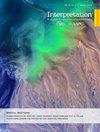陆上油田岩石物理组相分析与地质统计学相结合
IF 1.1
4区 地球科学
Q3 GEOCHEMISTRY & GEOPHYSICS
Interpretation-A Journal of Subsurface Characterization
Pub Date : 2022-11-10
DOI:10.1190/int-2022-0010.1
引用次数: 0
摘要
储层相研究在油气田勘探开发的不同阶段具有重要意义。我们的目标是为位于伊朗西南部的一个陆上油田的Asmari组建立一个储层相模型。使用了电相(EF)聚类算法的输入数据,包括四口井的伽马射线(GR)、密度(RHOB)、孔隙度和声波测井。通过岩心资料(注汞毛细管压力)和测井分析,得到了岩石物性组(PG)和EF类。PGs和测井EF的集成显著降低了储层建模的不确定性,从而提高了油田开发决策。我们比较了基于多分辨率图的聚类(MRGC)和k-means聚类方法。EF聚类结果发现了9个EF类。我们根据低GR、RHOB和高孔隙度测井曲线来圈定优质储层。接下来,我们将聚类结果应用于静态储层建模过程中,采用顺序指数模拟和指标克里格方法。将得到的相模型与现有岩心数据进行对比,发现MRGC算法的绝对百分比误差小于k-means算法。研究结果可为所研究油田油气勘探规划的制定提供参考。本文章由计算机程序翻译,如有差异,请以英文原文为准。
Integrating facies analysis and geostatistical methods in an onshore oil field using petrophysical groups
Reservoir facies studies are of great importance in different stages of exploration and development of hydrocarbon fields. We have aimed to generate a reservoir facies model for the Asmari Formation in an onshore oil field located southwest of Iran. Input data for electrofacies (EF) clustering algorithms are used, which include gamma-ray (GR), density (RHOB), porosity, and sonic logs from four wells. We obtain the petrophysical group (PG) and EF class using core data (mercury injection capillary pressure) and well-logs analysis. The integration of PGs and log EF significantly decreases the uncertainty in reservoir modeling, which alternatively enhances field development decisions. We compare the multiresolution graph-based clustering (MRGC) and k-means clustering methods. EF clustering results find nine EF classes. We delineate high-quality reservoirs based on lower GR, RHOB, and high-porosity logs. Next, we use the clustering results in the static reservoir modeling process, using the sequential index simulation and indicator kriging methods. The comparison between the facies obtained models and existing drilling core data finds that the absolute percentage error of the MRGC algorithm is less than that of the k-means algorithm. The results obtained by this study can provide useful information for the development of hydrocarbon exploration plans in the studied oil field.
求助全文
通过发布文献求助,成功后即可免费获取论文全文。
去求助
来源期刊

Interpretation-A Journal of Subsurface Characterization
GEOCHEMISTRY & GEOPHYSICS-
CiteScore
2.50
自引率
8.30%
发文量
126
期刊介绍:
***Jointly published by the American Association of Petroleum Geologists (AAPG) and the Society of Exploration Geophysicists (SEG)***
Interpretation is a new, peer-reviewed journal for advancing the practice of subsurface interpretation.
 求助内容:
求助内容: 应助结果提醒方式:
应助结果提醒方式:


